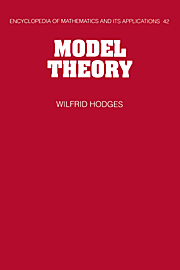Book contents
- Frontmatter
- Contents
- Introduction
- Note on notation
- 1 Naming of parts
- 2 Classifying structures
- 3 Structures that look alike
- 4 Automorphisms
- 5 Interpretations
- 6 The first-order case: compactness
- 7 The countable case
- 8 The existential case
- 9 The Horn case: products
- 10 Saturation
- 11 Combinatorics
- 12 Expansions and categoricity
- Appendix: Examples
- References
- Index to symbols
- Index
Appendix: Examples
Published online by Cambridge University Press: 08 October 2009
- Frontmatter
- Contents
- Introduction
- Note on notation
- 1 Naming of parts
- 2 Classifying structures
- 3 Structures that look alike
- 4 Automorphisms
- 5 Interpretations
- 6 The first-order case: compactness
- 7 The countable case
- 8 The existential case
- 9 The Horn case: products
- 10 Saturation
- 11 Combinatorics
- 12 Expansions and categoricity
- Appendix: Examples
- References
- Index to symbols
- Index
Summary
And thirteenthly….
From a sermon of Meister Eckhardt.This appendix is something of a ragbag. It assembles results on various interesting theories, from modules to linear orderings. The section on nilpotent groups proves a deep theorem of Alan Mekler, who died while this book was in proof; I dedicate the section to his memory. The section on groups mentions some themes which dominated model-theoretic research in the 1980s.
Modules
I discuss only left modules over a fixed ring with 1, so that the language and axioms of (2.21) in section 2.2 are appropriate. Also the results will all be concerned with the logical classification of modules. For example I say virtually nothing about the structure theory of pure injective modules, the Ziegler toplogy or representation types, three topics which have generated a quantity of recent research. Prest [1988] is full of up-to-date information.
Quantifier elimination
Most work on the model theory of modules begins with the Baur–Monk quantifier elimination theorem, Corollary A.1.2 below. The heart of the proof lies in Theorem A.1.1 (which is discussed by Gute & Reuter [1990]). I follow the argument of Monk [1975], though he stated it only for abelian groups.
- Type
- Chapter
- Information
- Model Theory , pp. 653 - 715Publisher: Cambridge University PressPrint publication year: 1993



